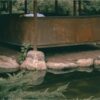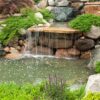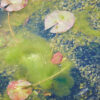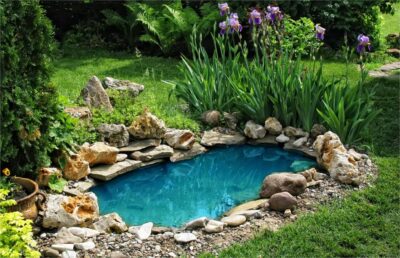How to create a pond? Pond ! Never has it been easier to own a pond A pond is a body of still, freshwater whether it was arranged by Mother Nature making it a natural pond or with the action of men making it an artificial pond, we can’t say that one is better than the other as they each have their drawbacks and advantages. Everything on this planet needs to be maintained, ponds don’t deviate from the rule!
The goal is to maintain a balanced ecosystem, without proper care you will end up making a paradise for algae. In this guide, you will know everything you need about owning a pond, from the benefits to the technical aspects, if you follow this guide you be confident on your decision.
What pond is right for you? Generally speaking, a natural pond also known as a biotope pond is one that exists in nature and is not manmade but we can also define it as a pond regulated by the nature without the use of equipment like pumps and filters a balanced harmony will be achieved with no major changes occurring, every inhabitant of the system plays its role, some organisms die and their rests gives rise to new life, yet, it can’t avoid needing some assistance now and again.
On the other hand, we have man-made ponds also called artificial ponds which can be created anywhere you want them, these ponds require routine checkups in order to remain in good operational condition with the use of special equipment like pumps and filters, they are used to nurture specific fish breeds or may also be used as a place for people to unwind and commune with nature.
What are the drawbacks for each type of pond?
Natural ponds: One major drawback of this type of pond is the growth of algae as it is an eye killing the aesthetics of the pond invasive algae can also be a big problem for other inhabitants of the system algae drain essential oxygen, even though any healthy pond ecosystem has algae as a regular component the lack of maintenance can become a major problem.

One major drawback of this type of pond is the growth of algae as it is an eye killing the aesthetics of the pond invasive algae can also be a big problem for other inhabitants of the system algae drain essential oxygen, even though any healthy pond ecosystem has algae as a regular component the lack of maintenance can become a major problem.
Artificial ponds :
As its name suggest an artificial pond isn’t supposed to be there so to keep it functioning it needs a lot of care and maintenance, meaning you can’t escape from buying tools and pieces of equipment to maintain it.

What are advantages of each type of pond?
Natural ponds:
Like gardens, biotope ponds frequently have an overgrown and untamed appearance, but this can add to their appeal in the eyes of some people, also the low maintenance and cost-effectiveness make them perfect for people who love to contemplate nature’s loving hand.
Artificial ponds:
With this type of pond, your imagination is the limit, they can come of all shapes and sizes with a wide variety of uses and purposes, this type of pond ranges from koi ponds to garden ponds, which is the meeting between a koi pond and Biotope ponds, we will learn about the later on this article.
How can I acquire a pond?
Biotope ponds:
If you are considering this type of pond you are a lover of unspoiled nature as they often have next to no technical equipment, as a result, leaves will always fall into the water and over time will build up into a layer of sludge that is thicker and thicker nevertheless some maintenance will be required, especially during the autumn as large quantity of foliage will end up on your pond. You can choose a method of preventing leaves from getting in the water, otherwise removing them comes as a second-best option.
Garden ponds:
The idea behind a garden pond is to make it blend with your home as a part of a set of decorations thus the design is a matter of taste, however, a set of rules should be considered as the oxygen is better distributed on flat surfaces, also making it easier for marsh plants to grow, another aspect of a pond that is often overlooked is the depth as a minimum of 180 cm is recommended for guarantying survival of animals through hard winters.
What technical equipment will you need?
Whether you choose to go for a natural or a garden pond a set of useful equipment will make your life easier and your pond flourish and inspire grantees and beauty.
Pond filters and pumps:
As its name suggest the main purpose of the filter is to keep the pond clean, as for the pump it helps circulate the water, when looking for a pump-filter duo the most important criteria is the filter volume, depending on the volume of your pond you can determine easily the equipment needed.
Ultra Violet Sterilization and Clarification (UV-C):
By incorporating a UV-C clarifier in your pump or filtration setup, you have a very easy solution to keep algae under control, as the UV-C will successfully neutralize algae that approach it.
Aeration:
Increasing or maintaining the amount of dissolved oxygen in a pond is the key to a healthy pond and keeping its dwellers happy and lively, a fraction of the oxygen gets into the pond naturally through the wind, rain or waterfalls, or even the actions of its inhabitants. But often it’s not sufficient; however, you achieve good aeration using technology. Here are the essentials you will need.
- Compressor: as its name suggests it is a device that pumps compressed air directly to the bottom of your pond.
- A set of tubing: they carry compressed air from your pump to the bottom of the pond, and we recommend using PVC tubes as they will maintain themselves on the bottom thanks to their weight.
- Diffuser: create a large number of tiny air bubbles rising from the bottom to the surface creating aeration and circulation.

What can you have in your pond?
As time passes various new animals and plants will call your pond home, mostly hatching from eggs that have been accidentally carried by birds or plants, you can either accept it as a natural process of life or you can take action to get rid of them. Regardless of that, you can personalize your pond to fit your liking, and for that, you can count on various exotic species of fish and plants. Here is a selection of a few fish species that you should take a look at.
The ideal pond fish can grow to 30 cm in length when grown in outdoor ponds, count on him managing the growth of algae as they feed on it and water insects.

- Koi fish
they can up to 5 years given the right condition and grow up to 100cm, more than 100 different types of koi fishes have been developed via breeding, the primary hues include white, black, red, yellow, blue, and cream.

- Starlet
The ideal garden pond fish, the smallest species of its family rarely exceeding 90 cm, it’s the best fish for a beginner.
- Carps
Many species of carp can grow up to 100 cm for some species; they are commonly used to combat algae issues and also help to clarify the water when eating plankton.

- Bluegill
a small species of fish they can grow a maximum of 30cm, They are usually olive green or blue-green on top and yellowish on the belly, Black spots on edge of its gills are distinctive to bluegills.

- Minnow
Small colorful fish do not exceed 15cm, perfect for maintaining the density of insects and small animals.

- Sunbleak
Really small silvery fish rarely reaching 5cm they will add a lot of movements to your pond.
When it comes to plants they add a decorative aspect to your garden, having healthy plants ensure a healthy pond, whether they are underwater or on the surface, the beneficial aspect of it is what truly matters.

- Water lilies
It is a must for every pond! They play a huge role in cooling down the water and giving shade to the fish. Without forgetting the additional beauty they bring with the various colors of their flowers.

- Water lettuce
Frequently used as a decorative plant in garden ponds, easy to grow giving shades for small fishes in your ponds, the only drawback is its tendency to be invasive.
- Watermilfoil
The first underwater plant on our list is used for it for its therapeutic aspect, as it lowers the germs count with its antibacterial effect and gives better immunity to your fish.

- Pickerel plant
When covering a big space the arrangements of its various colors give the edges of the ponds a unique display.
- Horsetail reed
Long vertical segmented plant, perfect for European countries, simple yet adding rustic charm to the edges of our pond
- houttuynia cordata
You either love it! Or hate it; also called chameleon plant, Grown for its intriguing variegated leaves.
- Creeping jenny pond plants
A great addition to softening the edges of your pond, growing up to 5cm in height
How can you take care of your pond?
- food: often ponds owner tends to be afraid of starving their fish to death, it’s a common mistake when beginning the pond adventure, when dealing with young animals the frequency of food supply comes before the quantity, a basic rule to follow is that only add food to your pond if it was eaten after 5 minutes.
- Plants care: Plants care: plants help you take care of your pond, but you should also look after them in return, for starters be sure you choose the right spot for each species, some species also need to be cut in late autumn
.
One thing that should never be overlooked when dealing with plants on your pond is the removal of dying plants, as the unwanted supply of organic matter on your pond will promote algae growth.
How can you introduce a new fish to your pond?
A fish is a living organism, thus avoiding stress is a must! There are a lot of safety concerns you should think about before transporting fish.
- The ideal method of transportation is a bucket with a lid. You can run a battery-powered pump connected to a tub directly into your bucket.
- Doing water changes during transport changes approximately 25% of the water every hour.
- Keep your bucket in the shade and avoid any sudden movements
What issues can you except?
Holidays
Planning holidays can become an issue if not planned correctly thus some preparations are required
- The water level should be at the maximum before leaving
- Acquiring an automatic feeder and supplying it with enough food
- An inspection check for all the equipment is a must
- Make sure of cleaning the filters
Water treatments:
Although maintaining the water supply may seem strange, it is actually one of the most crucial maintenance procedures.
- Water quality: rainwater can seem like a blessing but not so much when thinking about technical aspects of it, as it is distilled containing no minerals and is also often acidic so a steady supply of water is required.
- Accidentals poisoning: if you see any worrying behavior of your fish or in the worst cases death this can indicate some sort of poisoning, various bacteria will be needed depending on the poison type.
- Water stability monitoring your water is essential as it’s the living environment of your ecosystem so you should strive to maintain a pH of 7, you can achieve that by adding chemicals like nitrites and carbonates
If you have made it this far, congratulations! You are ready to go one step further by starting your planning, and even digging! You will have the ecosystem of your liking in your garden.










